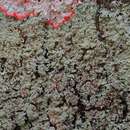en
names in breadcrumbs


Pyxine is a genus of foliose lichens in the family Caliciaceae.[2] The genus has a widespread distribution in tropical regions.[3]
The presence or absence of the compound lichexanthone is a character used in classifying Pyxine species; about 20 species contain this compound. This represents the largest group of foliose lichens with the compound.[4]
Pyxine is a genus of foliose lichens in the family Caliciaceae. The genus has a widespread distribution in tropical regions.
The presence or absence of the compound lichexanthone is a character used in classifying Pyxine species; about 20 species contain this compound. This represents the largest group of foliose lichens with the compound.